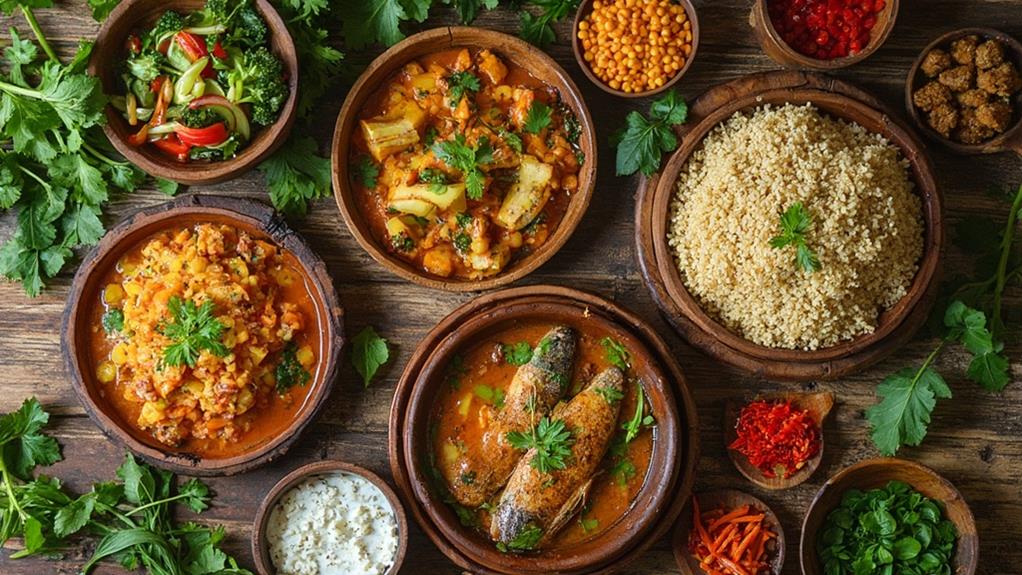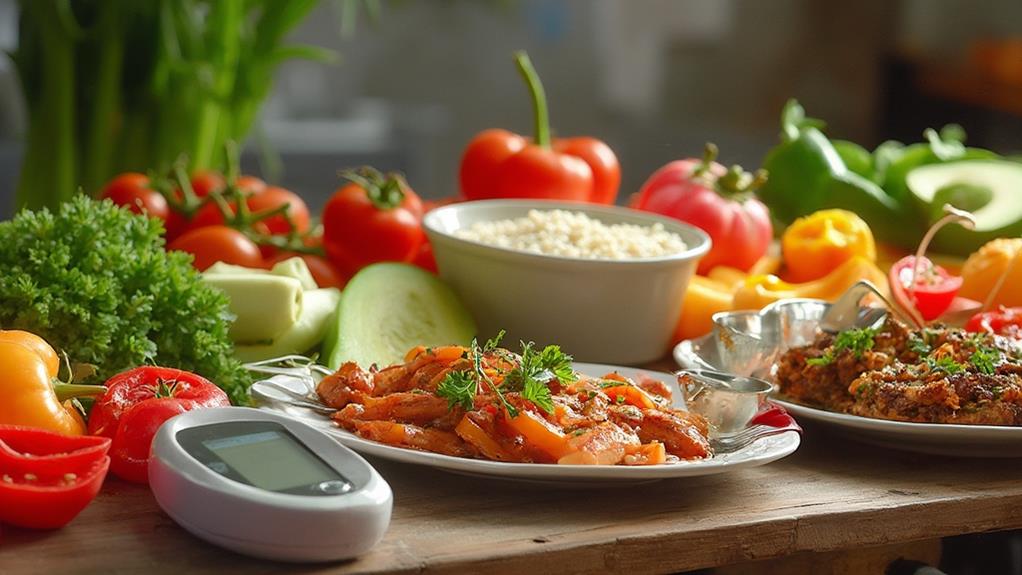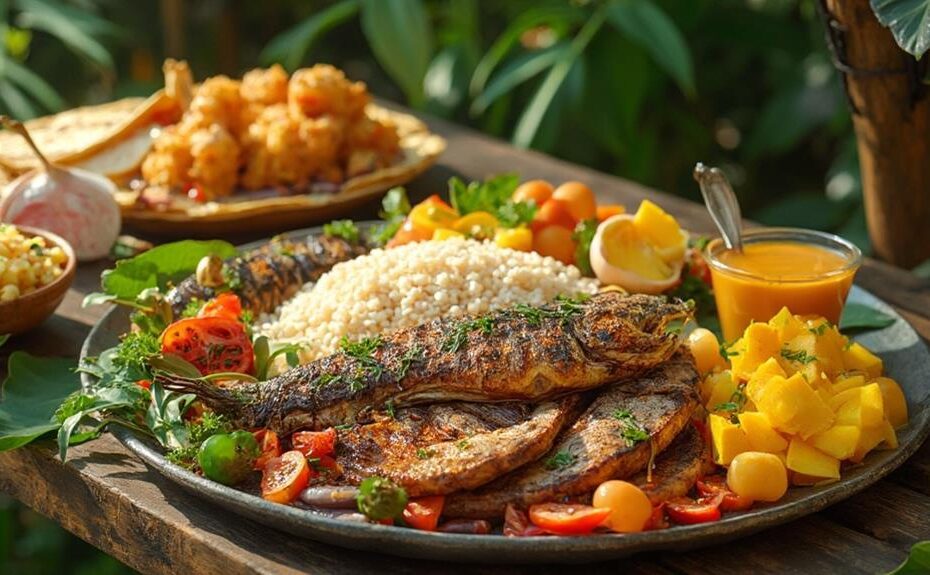Managing Blood Sugar Levels with Filipino Cuisine
Choose Whole Grains and Non-Starchy Vegetables
When cooking Filipino dishes, opt for whole grains like brown rice or quinoa instead of white rice to manage blood sugar levels.
Additionally, incorporate plenty of non-starchy vegetables into your meals.
Diabetic-Friendly Twists on Classic Dishes
Dishes like Adobong Manok can be made diabetic-friendly by using skinless chicken and serving it with cauliflower rice.
This modification maintains the flavor while supporting blood sugar management.
Balance Carbohydrates with Healthy Fats and Lean Proteins
Pairing carbohydrates with healthy fats and lean proteins, as in Sinigang na Isda, helps stabilize blood sugar levels.
This balanced combination is essential for managing diabetes.
Smart Ingredient Swaps
By swapping traditional ingredients wisely, you can maintain the essence of your favorite Filipino meals while supporting your health.
This approach enables you to enjoy delicious dishes while managing blood sugar levels.
Understanding Diabetes and Nutrition
Understanding Diabetes and Nutrition
Managing Blood Sugar with Carbohydrates
When you have diabetes, your body struggles to regulate blood sugar levels, making it essential to pay attention to what you eat. Carbohydrates have the most significant impact on your blood sugar. Focus on choosing complex carbohydrates over simple ones. Whole grains, legumes, and vegetables provide fiber, which helps stabilize blood sugar levels.
For example, brown rice, quinoa, and whole-grain bread are good sources of complex carbohydrates.
Portion Control and Meal Timing
Portion control is key; it's important to monitor serving sizes to avoid spikes in glucose. Regular, balanced meals can help prevent extreme fluctuations in blood sugar.
Consider pairing carbohydrates with proteins or fats for a more balanced approach. For instance, pair whole-grain toast with scrambled eggs or avocado for a balanced breakfast.
Incorporating Healthy Fats and Proteins
Incorporating healthy fats, like avocados and nuts, can be beneficial, as they slow down digestion and help maintain steady energy levels.
Lean proteins, such as chicken and fish, can keep you feeling full without affecting your blood sugar significantly. For example, grilled chicken or fish with roasted vegetables make for a healthy and balanced meal.
Staying Hydrated
Staying hydrated is vital; water is always the best choice. Aim to drink at least eight glasses of water per day to help regulate blood sugar levels and overall health.
Key Ingredients for Diabetic Cooking
Whole Grains Are a Must
When cooking for diabetes, whole grains are a better choice than refined grains.
Brown rice and quinoa are excellent options because they've a lower glycemic index and provide essential fiber, which helps regulate blood sugar.
Non-Starchy Vegetables Are Essential
Include plenty of non-starchy vegetables in your diet, such as leafy greens, bell peppers, and broccoli.
These vegetables are low in calories and carbs, making them ideal for feeling full without spiking your blood sugar.
Lean Proteins Support Overall Health
Skinless chicken, fish, and legumes are excellent lean protein choices.
They support muscle health and help you maintain steady glucose levels.
Healthy Fats Are Crucial
Avocados, nuts, and olive oil are healthy fat sources that can improve heart health and promote satiety.
Spices Can Be Beneficial
Cinnamon and turmeric may help improve insulin sensitivity, making them beneficial additions to your meals.
How Can Filipino Adobo Recipes Be Modified to Be Diabetic-Friendly?
Filipino Adobo recipes can be made diabetic-friendly by using low-sodium soy sauce and cutting back on sugar. Additionally, swapping out fatty meats for leaner options like chicken breast or tofu can also make a difference. Despite these modifications, the health benefits of adobo, such as its protein content and savory flavors, can still be enjoyed.
Traditional Filipino Dishes Made Healthy

Traditional Filipino dishes can be adapted to fit a diabetic-friendly lifestyle without sacrificing flavor. By making simple ingredient swaps and cooking techniques, you can enjoy traditional meals while managing your blood sugar levels.
Make Whole Grains a Priority: Whole grains like brown rice or quinoa have a lower glycemic index, which helps keep your blood sugar stable. Replace white rice with these options to reap the benefits.
Limit Added Sugars: Reduce sugar spikes by using natural sweeteners like stevia or monk fruit in desserts like leche flan or halo-halo. These alternatives provide sweetness without the negative impact on blood sugar levels.
Incorporate More Vegetables: Adding more vegetables to dishes like adobo or sinigang promotes better digestion and blood sugar control.
Vegetables are low in calories and high in fiber, making them an ideal addition to your meals.
Easy Diabetic-Friendly Recipe Ideas
Easy Diabetic-Friendly Recipe Ideas
Managing diabetes doesn't mean sacrificing flavor. Start with a hearty breakfast like *Tortang Talong*, or eggplant omelet. Roast eggplants, mash them, and mix with eggs. Cook in a non-stick pan for a delicious, low-carb breakfast.
For a nutritious lunch, try *Sinigang na Isda*, a savory fish soup. Use low-sodium broth and plenty of vegetables like radish, spinach, and tomatoes. This dish isn't only comforting but also rich in nutrients and fiber.
Dinner can feature *Adobong Manok*, chicken adobo. Opt for skinless chicken thighs, marinate in vinegar, soy sauce, garlic, and pepper, then simmer until tender.
Serve it with steamed cauliflower rice for a satisfying meal that won't spike your blood sugar.
For a healthy snack, whip up a refreshing *Buko Salad* using fresh coconut, unsweetened yogurt, and a sprinkle of nuts.
It's a great way to satisfy your sweet tooth healthily. These recipes help you enjoy Filipino flavors while keeping your blood sugar in check.
Tips for Managing Blood Sugar Levels

Managing blood sugar levels effectively is crucial for anyone living with diabetes. To take control of your health, you need to adopt a few simple strategies.
Monitor Your Carbohydrate Intake: Keeping track of carbohydrates in your meals is essential. Opt for whole grains, legumes, and vegetables, which slow down sugar absorption, helping to maintain stable blood sugar levels.
For example, choose brown rice instead of white rice, and include vegetables like broccoli and carrots in your meals.
Stay Active: Regular physical activity significantly improves insulin sensitivity. Aim for at least 150 minutes of moderate exercise each week, such as walking, biking, or dancing.
This can be achieved by doing 30 minutes of exercise, five days a week.
Plan Your Meals: Creating a meal plan that emphasizes balanced nutrition is vital. Incorporate protein, healthy fats, and fiber-rich foods to keep your blood sugar steady.
Eating smaller, more frequent meals can also prevent spikes in glucose levels.
For instance, include protein sources like chicken and fish, healthy fats like avocado, and fiber-rich foods like whole grain bread and fruits in your meals.
